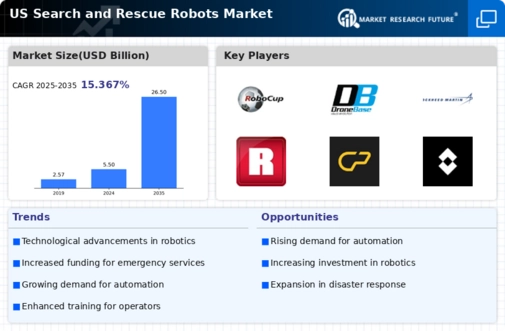Government Initiatives and Funding
Government initiatives aimed at enhancing public safety are playing a crucial role in the growth of the search and-rescue-robots market. Federal and state agencies are increasingly allocating funds for the development and deployment of advanced robotic systems in emergency response. Programs designed to improve disaster preparedness and response capabilities often include provisions for acquiring search and-rescue robots. For example, the Federal Emergency Management Agency (FEMA) has been known to support local agencies in procuring such technologies. This financial backing not only facilitates the adoption of innovative solutions but also encourages research and development in the field. As a result, the search and-rescue-robots market is likely to see sustained growth, driven by ongoing government support.
Advancements in Robotics Technology
Technological innovations in robotics are transforming the search and-rescue-robots market. The integration of artificial intelligence, machine learning, and advanced sensor technologies is enabling robots to perform complex tasks with greater autonomy and efficiency. These advancements allow robots to navigate challenging terrains, identify victims, and assess hazardous conditions more effectively. For instance, the development of drones equipped with thermal imaging cameras has revolutionized search operations, allowing for quicker identification of individuals in distress. As these technologies continue to evolve, the search and-rescue-robots market is expected to expand, with a projected market value reaching $1 billion by 2027. This growth is indicative of the increasing reliance on robotic solutions in emergency scenarios.
Rising Public Awareness and Training
Public awareness regarding the capabilities of search and-rescue robots is on the rise, leading to increased interest and investment in this technology. As communities become more informed about the benefits of robotic assistance in emergencies, there is a growing push for training programs that incorporate these tools into standard emergency response protocols. This trend is particularly relevant in urban areas, where the integration of technology into emergency services is becoming a priority. Training initiatives not only enhance the effectiveness of search and-rescue operations but also foster collaboration between human responders and robotic systems. Consequently, the search and-rescue-robots market is expected to expand as more organizations recognize the value of incorporating these advanced tools into their emergency response strategies.
Growing Demand for Emergency Response Solutions
The increasing frequency of natural disasters and emergencies in the US has led to a heightened demand for effective emergency response solutions. This trend is particularly evident in urban areas, where the need for rapid and efficient search and rescue operations is paramount. The search and-rescue-robots market is poised to benefit from this growing demand, as these robots can significantly enhance the capabilities of emergency responders. According to recent estimates, the market is projected to grow at a CAGR of approximately 15% over the next five years, driven by the need for advanced technologies that can operate in hazardous environments. As municipalities and emergency services seek to improve their response times and effectiveness, investments in search and-rescue robots are likely to increase, further propelling market growth.
Collaboration Between Private Sector and Public Agencies
The collaboration between private companies and public agencies is emerging as a key driver in the search and-rescue-robots market. Partnerships that leverage the expertise of technology firms with the operational knowledge of emergency services are fostering innovation and improving the effectiveness of search and-rescue operations. These collaborations often result in the development of customized robotic solutions tailored to specific emergency scenarios. For instance, joint ventures may focus on creating robots capable of navigating urban environments or performing underwater rescues. As these partnerships continue to evolve, they are likely to enhance the capabilities of search and-rescue robots, thereby driving market growth. The search and-rescue-robots market stands to benefit significantly from this synergy, as it encourages the rapid deployment of advanced technologies in real-world situations.
























Leave a Comment